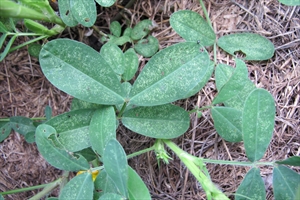Sweetpotato flea hopper, flea hopper, garden flea hopper, black garden flea hopper.
Pacific Pests, Pathogens, Weeds & Pesticides - Online edition
Pacific Pests, Pathogens, Weeds & Pesticides
Sweetpotato flea hopper (026)
Halticus species (Halticus tibialis, Halticus minutus)
In Oceania, Hilticus species are reported from Federated States of Micronesia, Guam, Marshall Islands, Northern Mariana Islands, Palau, Papua New Guinea, and Solomon Islands.
The flea hopper has many host plants, including brassicas (cabbages), cucurbits (watermelon, cucumber, melon, pumpkin, and others), beans, peanuts as well as sweetpotato. In Papua New Guinea, Halticus minutus is considered a serious pest of cucumbers.
Nymph and adult flea hoppers use their piercing-sucking mouthparts to feed on the leaves. As a result, the cells die and small whitish spots appear. When populations are high, spots develop in irregular-shaped patches scattered on the leaf surface. When populations are very high, patches join and the entire leaf becomes greyish-white or silver (Photos 1-3).
The adult is black or dark brown about 2 mm long (Photo 4). It has long and slender antennae. The hind legs are large, allowing the flea hopper to jump when disturbed. At such times, they often move quickly to the underside of the leaves. Eggs are inserted in leaf tissues; they are white to yellow and less than 1 mm long. In other species, they are placed in feeding punctures.
The eggs hatch in about 2 weeks, and the nymphs emerge. The nymphs are green at first, later becoming shiny black as they moult to become adults. A distinguishing feature of the adult (other than the long hind legs) is the length of the antennae, which are longer than the length of the body. There are short and long winged forms of the adults. The life cycle takes about 3-5 weeks.
There is no information on the impact of the flea hopper on sweetpotato; there is need to obtain this information in Pacific islands countries for sweetpotato and peanuts, in particular, as the flea hopper and the symptoms it causes are commonly seen on these crops. The faecal spots on foliage affects the appearance of vegetables and may lower their market value.
Look for the white dots on the top surface of the leaf, and black dots of excreta on both sides. Look for the small, black insects with large hind legs that move rapidly to the under surface of the leaf or jump when disturbed.
NATURAL ENEMIES
No natural enemies are recorded from Pacific islands, but in the USA tiny braconid wasps lay their eggs inside the nymphs and adults of Halticus bractatus and thought to control populations. Parasitoids probably exist in the Pacific islands, too.
CULTURAL CONTROL
Cultural control is difficult because the flea hoper has a wide host range.
Before planting:
- When infestations are high, do not take sweetpotato planting material (cuttings) from the plots for replanting. Eggs of the flea hopper will be taken at the same time.
- Do not plant any of the cropsthat are hostby the flea beetle next to those that are already infested. Often new sweetpotato plots are made next to older ones with vines infested with flea hoppers that spread easily to the new plants as they develop.
During growth:
- Test Chinese cabbage, collards, mustard or radish as a trap crop. In Guam, populations of the flea hopper were reduced when head cabbage was grown with these plants.
- As Halticus breeds on weeds, wild Ipomoea species in particular, it is important to keep fields free of weeds; otherwise, the pest will breed on them and migrate to sweetpotatoes and other crops.
After harvest:
- Collect the harvested vines and other debris and burn them, otherwise the flea hopper will continue to breed and spread to new crops. Hygiene is very important in the control of this disease.
CHEMICAL CONTROL
- Use plant-derived products, such as neem, derris, pyrethrum and chilli (with the addition of soap). (For the use of neem and chilli see Fact Sheet nos. 402, 504, respectively; for derris see Fact Sheet no. 56).
- Use microbial insecticides, synthetic products derived from microorganisms, such as abamectin, Bt - Bacillus thuringiensis, and spinosad.
- Alternatively, use synthetic pyrethroids; they are likely to be effective, but will also kill natural enemies.
--------------------
Note, derris (Derris species) contains rotenone, an insecticide, often used as a fish poison; it should be used with caution. The commercial derris insecticide is made from Derris elliptica.
____________________
When using a pesticide, always wear protective clothing and follow the instructions on the product label, such as dosage, timing of application, and pre-harvest interval. Recommendations will vary with the crop and system of cultivation. Expert advice on the most appropriate pesticide to use should always be sought from local agricultural authorities.
AUTHORS Helen Tsatsia & Grahame Jackson
Information from Capinera JL (1999) Garden fleahopper Halticus bractatus. University of Florida. (http://entnemdept.ufl.edu/creatures/veg/leaf/fleahopper.htm).
Produced with support from the Australian Centre for International Agricultural Research under project PC/2010/090: Strengthening integrated crop management research in the Pacific Islands in support of sustainable intensification of high-value crop production, implemented by the University of Queensland and the Secretariat of the Pacific Community.







